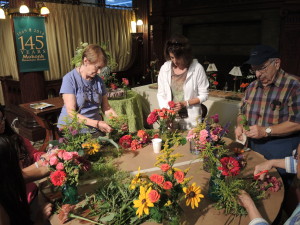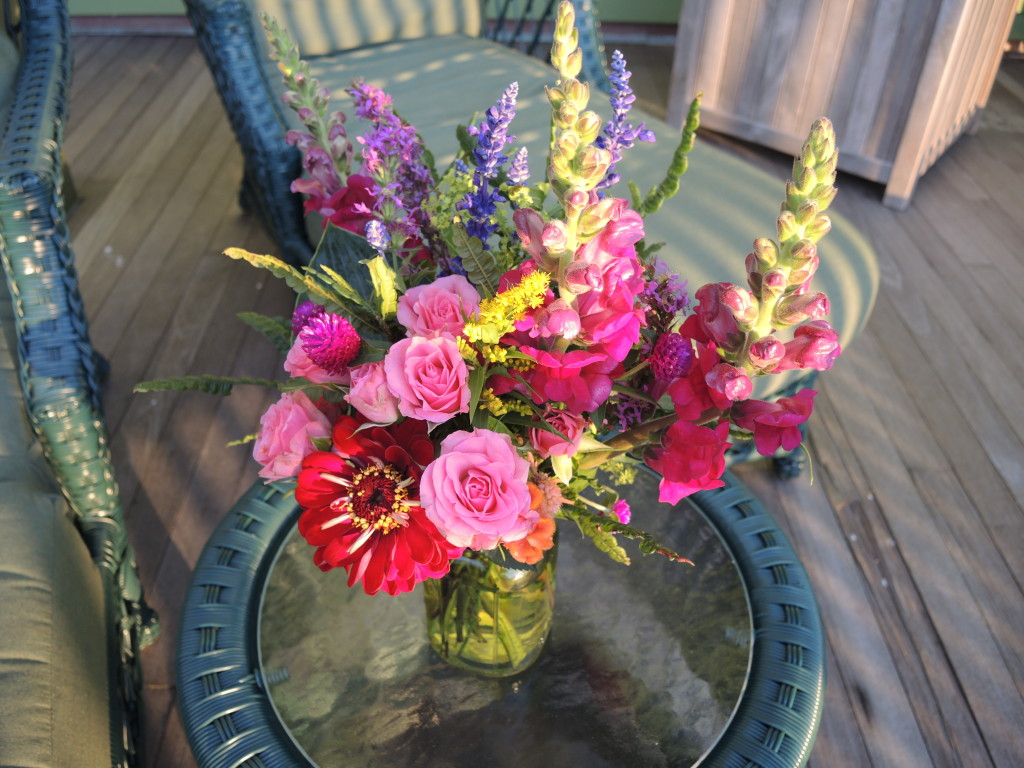Did you ever wonder how florists create those perfect arrangements? Ever wonder why your own, by contrast, appear boring and “one-sided”—fine from the front, but mediocre from any other angle? Whether you’re aiming for a tight little bouquet to sit on the dinner table without blocking people’s view—or a taller, more dramatic arrangement to grace your front hall—there is one principle to keep in mind, says florist Carol Cramer, who creates dozens of arrangements every week for Mohonk Mountain House in New Paltz, NY. “You want to think like an artist, with attention to color, texture, and form.” In a hands-on workshop she gave as part of Mohonk’s annual Garden Holiday, she showed us how to start applying this to our own creations. Here are some of the lessons I took away.
COLOR:
Think beyond supermarket flowers. A $10 bouquet from the local bodega may fulfill the basic requirement for flowers on the table. But it’s unlikely to have the variety you want. “That’s why you need a garden,” says Cramer—or at least a place where you can buy individual stems, so that you can mix and match them for the desired effects. The bouquet doesn’t have to be expensive. You can even add wildflowers and weeds—such as goldenrod, purple loosestrife, and scented ferns. These will give you different forms, textures, and colors that will make your creation more interesting.
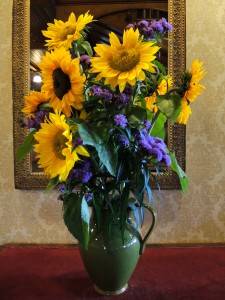 Choose a base color for your flowers and complement it. Did you ever notice how paintings by the artist Paul Gauguin look so vibrant? Gauguin was a master of complementary colors—that is, colors opposite each other on the color wheel. Purple and yellow are complementary colors. So are green and red–or orange and blue. These combinations “pop,” for a simple reason. Stimulating the eye’s color-perceiving cones creates an after-image of its opposite, complementary color, so the two intensify each other. (For a vivid example of how this works, click here. After staring at the green-on-red image, you will look away and see the identical after image, but reversed—red-on-green.) You don’t have to be scientific about this in your arrangement. Just be aware that each slightly different shade will have its own complementary color. Once you’ve chosen the base color of your flowers, says Cramer, “see how it changes depending on what colors are next to it.”
Choose a base color for your flowers and complement it. Did you ever notice how paintings by the artist Paul Gauguin look so vibrant? Gauguin was a master of complementary colors—that is, colors opposite each other on the color wheel. Purple and yellow are complementary colors. So are green and red–or orange and blue. These combinations “pop,” for a simple reason. Stimulating the eye’s color-perceiving cones creates an after-image of its opposite, complementary color, so the two intensify each other. (For a vivid example of how this works, click here. After staring at the green-on-red image, you will look away and see the identical after image, but reversed—red-on-green.) You don’t have to be scientific about this in your arrangement. Just be aware that each slightly different shade will have its own complementary color. Once you’ve chosen the base color of your flowers, says Cramer, “see how it changes depending on what colors are next to it.”
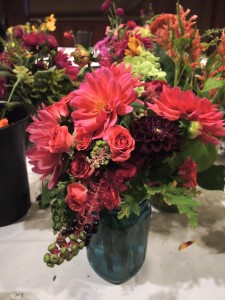 Layer colors in the same family. Any color can get monotonous very quickly if you use a solid block of it. But you can prevent this by using different shades in the same overall family.
Layer colors in the same family. Any color can get monotonous very quickly if you use a solid block of it. But you can prevent this by using different shades in the same overall family.
Don’t forget your greens. Foliage tends to be an afterthought. It shouldn’t be. It adds everything you want—contrasting color, different textures, and new forms. Cramer particularly likes greenery that’s a bright chartreuse. “Chartreuse makes the other colors pop,” she says. “Chartreuse keeps it lively.”
Remember that the vase is part of your arrangement. The vase may look pretty on its own, but does it match the flowers you’ve chosen? Delicate pink roses might look pretty in a cream-colored vase. But boldly colored dahlias look better in a more brightly colored container. Particularly trendy now are colored Mason jars, which we used in our class (photo, left).
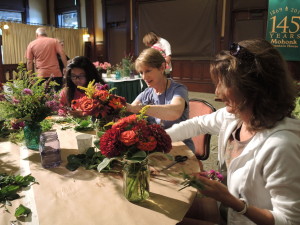 TEXTURE:
TEXTURE:
Use a variety of textures. Different textures create resting spots for the eyes, says Cramer. Velvety coxcomb is nice, for example, against smooth dark leaves or berries. Dusty miller gives a soft, silvery sheen.
Let it breathe. A lot of round-faced flowers like dahlias or zinnias may be lovely. But unless you have a perfectly round, tight bouquet, you probably want something spikey or airy to break it up. That’s where something like goldenrod or purple loosestrife can be useful—or snapdragons or delphiniums, if you have them in your garden.
FORM:
Finally—drumroll, please—Cramer addressed my number-one problem, “one-sidedness.” You can see how well her solution works in the photos below, which show my arrangement from the front, back, and above. (OK, I’m no pro, but believe me, this is progress.)
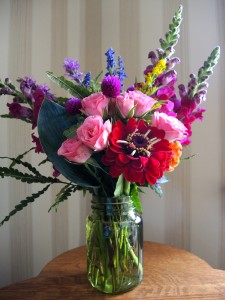 Turn your bouquet with each flower you add. There’s a simple reason why my arrangements are one-sided. I start by putting a stem into the vase, then trying to arrange the others around it—all while staring at it from the same angle. To get an arrangement that’s balanced on all sides, you have to keep turning it. You can do this by turning the vase, but Cramer also demonstrated how to do this while assembling the bouquet in her hand.
Turn your bouquet with each flower you add. There’s a simple reason why my arrangements are one-sided. I start by putting a stem into the vase, then trying to arrange the others around it—all while staring at it from the same angle. To get an arrangement that’s balanced on all sides, you have to keep turning it. You can do this by turning the vase, but Cramer also demonstrated how to do this while assembling the bouquet in her hand.
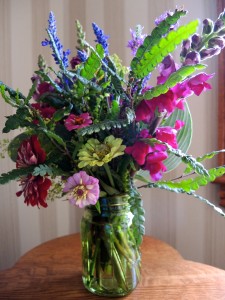 Here’s how. Place a few flowers in your left hand as you’d like to see them in your arrangement. Then with your right hand, rotate the bunch a quarter of a turn to the right. Add another flower that would look good with the previous ones, and turn the whole bouquet again, a quarter of a rotation to the right. Continue this way until you’ve used all your flowers and greens, and–voilà!–you will find that you have an evenly balanced bouquet that looks good from multiple angles.
Here’s how. Place a few flowers in your left hand as you’d like to see them in your arrangement. Then with your right hand, rotate the bunch a quarter of a turn to the right. Add another flower that would look good with the previous ones, and turn the whole bouquet again, a quarter of a rotation to the right. Continue this way until you’ve used all your flowers and greens, and–voilà!–you will find that you have an evenly balanced bouquet that looks good from multiple angles.

